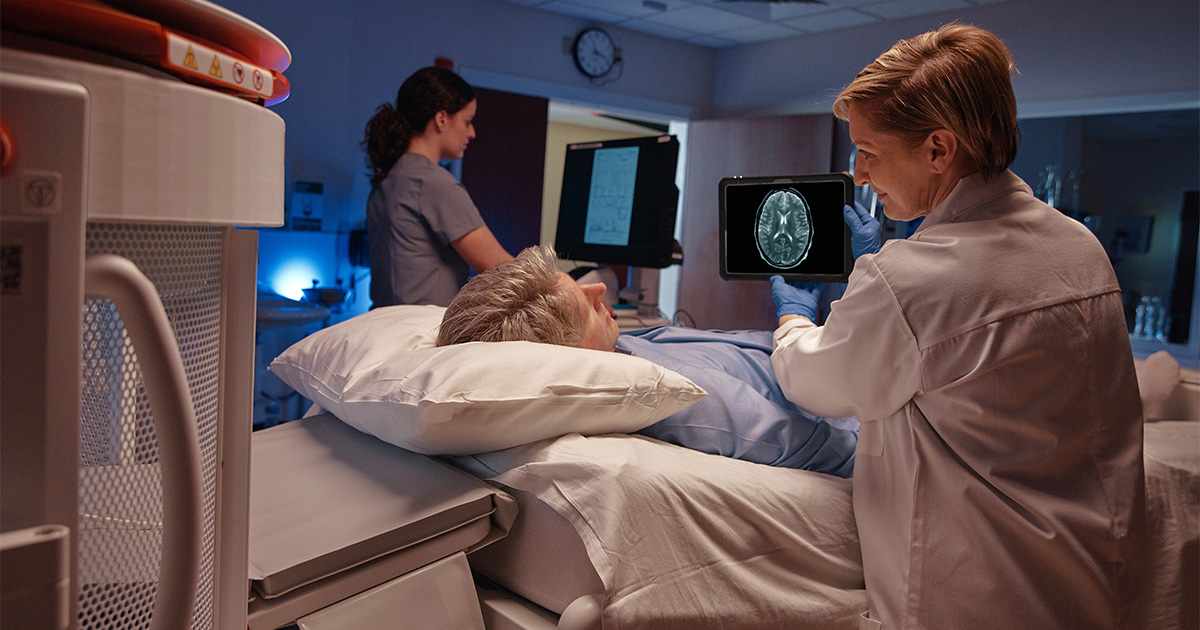Understanding MRI Brain Exams Without
Contrast: A Journey Inside the Mind

The Swoop System in Use
MRI (Magnetic Resonance Imaging) has become an indispensable tool in the world of neurology and radiology. This non-invasive imaging technology offers detailed views of our brain’s soft-tissue structures, which help clinicians diagnose a wide range of conditions. When undergoing a brain MRI exam, you might hear the term without contrast. What does this mean, and what can you expect from the procedure? Let’s dive in.
1. What is an MRI?
MRI is a medical imaging technique that uses magnetic fields and radio waves to generate images of the body’s soft tissues. It’s non-invasive, which means it doesn’t require any incisions. For brain imaging, MRI machines, such as the ultra-low-field Swoop system, offer a detailed look at the brain’s structures, allowing doctors to see anomalies, injuries, tumors, and other conditions.
2. What does without contrast mean?
In some conventional high-field MRI exams, a contrast agent is injected into the patient’s bloodstream to highlight specific areas by providing additional visual detail. An MRI without contrast doesn’t use contrast agents.
3. What is an MRI brain exam without contrast like?
If your doctor schedules you for an MRI brain exam without contrast, here’s what you can expect:
- Preparation: You’ll undergo a screening and be asked to remove any metal objects, including jewelry, glasses, and certain clothing items, as these can interfere with the MRI exam. In most cases, you can wear your clothes if they are metal-free.
- The MRI machine: With the ultra-low-field Swoop system, because of its portable design, patients can remain in their hospital room bed surrounded by care providers and family—and the MRI machine comes to them. By comparison, conventional MRI machines require a patient to move to another part of the hospital away from their room. Here, the patient is isolated in a specially shielded room and placed on a table that slides into a long tube for the duration of the exam.
- During the procedure: As an MRI machine works, you must stay still to ensure clear images. As the exam progresses, you’ll hear banging or tapping noises. These are normal. With the Swoop system, hearing protection is not necessary since it is much quieter than conventional MRI machines. With a conventional MRI scanner, clinicians often offer you earplugs to mitigate this noise.
- Duration: With the Swoop system, a scan usually takes 30 minutes or less. The entire process for a conventional MRI scan can take fifteen minutes to an hour, depending on what the doctor is looking for.
- Post-procedure: Since there’s no contrast agent used with the Swoop system, there’s no waiting time for it to wear off or get flushed from your system.
4. What are some benefits of an MRI brain exam without contrast?
While contrast agents can offer enhanced clarity in certain situations, MRIs without contrast have their own set of advantages:
- Safety: There is no risk of contrast agent retention in the body or, in rare instances, an allergic reaction.
- Clarity: An MRI without contrast can provide sufficiently clear images to diagnose many conditions.
- Convenience: Without contrast agent injection, the process can be quicker.
Conclusion
An MRI brain exam without contrast offers a detailed glimpse into one of the most vital organs in our body. While the idea of undergoing an MRI can seem daunting, understanding the process can help alleviate some of those nerves. Remember, if you ever have concerns or questions about your upcoming MRI exam, always consult your healthcare provider to get a clear picture of what to expect.
